Safe Repairs for a Gas Range
| HOME | Troubleshooting | DIY Tips |
|
.. A gas range is, in essence, a net work of pipes that carry gas to burners on the cooktop and in the oven, where it’s mixed with air and ignited to produce a controlled flame. Lighting the Gas: Some ranges have a high-voltage ignition module on the back panel of the range that sends current to an electric igniter when the burner is turned on. Other types use pilots that produce small, constantly burning flames that ignite the gas. Most problems with either system are caused by accumulated dirt and grease, which can foul the electrodes of electric igniters or clog the small apertures of the pilots. Routine Maintenance: Keeping the cooking surfaces clean is the best way to avoid problems, and modern ranges are designed with this in mind. Burner grates and drip pans lift off, and the hinged cooktop can be propped open. Oven doors slide off, and both the oven bottom and the oven burner baffle are re movable for easy cleaning and access to the oven burner. Anatomy of a gas range. 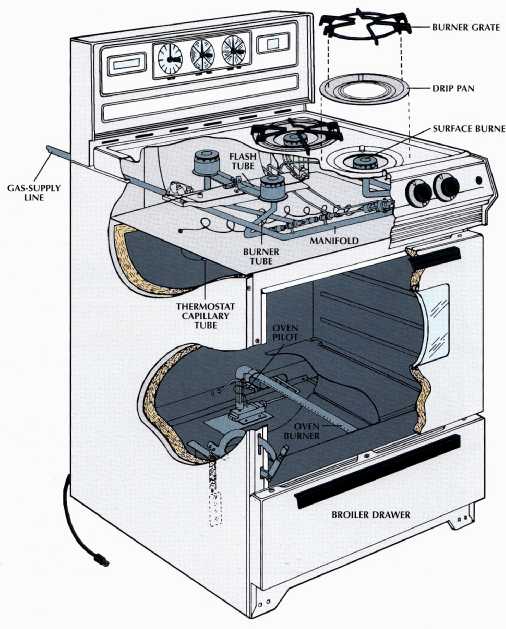
Natural gas enters the range through the supply pipe in the back. Inside, the pipe branches to carry gas to the oven burner and the manifold, which runs across the front of the range beneath the cooktop and distributes gas to the four surface burner units. An air shutter on each burner’s pipe mixes air with the natural gas. Turning the burner-control knob on the front of the range opens a valve that lets the air/gas mixture flow into the burner tube and the flash tube—where it’s ignited—and then through the small holes in the burner head. The oven burner is governed by a thermostat, which senses the tempera ture inside the oven by means of a capillary tube. CAUTION---If the pilot has been out for some time or if you detect an odor of gas, ventilate the room before relighting. Troubleshooting Guide
The ideal flame. 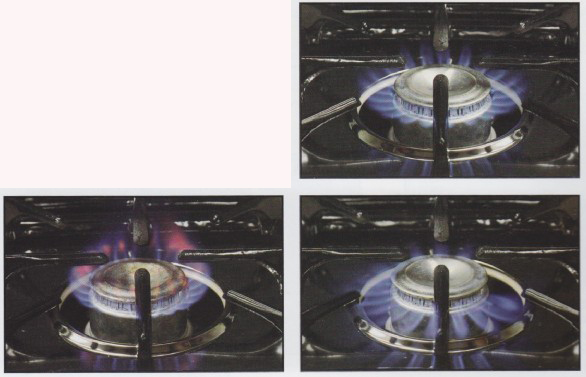
In the upper photograph at right, a properly adjusted burner shows a steady, quiet flame with sharply defined blue cones about 0.5 to 0.75 inch high. Insufficient air reaching the burner produces a weak red or yellow flame that may leave soot deposits on pots and pans. In the lower photograph at right, the burner is getting too much air, resulting in an uneven, noisy flame. SIMPLE FIXES FOR STOVETOP BURNERS Cleaning the pilot opening. 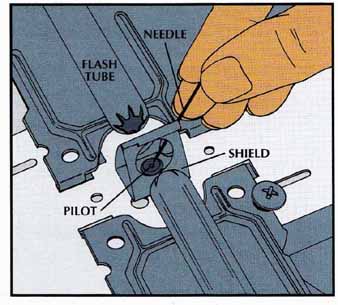
• Insert a needle into the hole in the center of the pilot and move it up and down, taking care not to enlarge or deform the opening. If the met al shield over the pilot presents an obstacle, gently lift it out of the way. • With all burner controls turned to the off position, relight the pilot frame with a match held at the opening. Clearing the portholes. 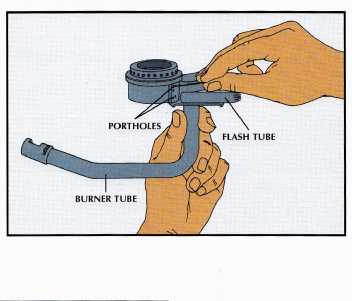
• With the range top propped open, lift out the burner assembly. It’s usually unanchored, held in place by its own weight. • Push a needle through each porthole (some burners have a vertical slot instead of portholes), then wash the burner head in warm, soapy water. • To reinstall the burner, slip the burner tube onto the gas manifold and align the flash tube with the pilot. Regulating the burner flame. 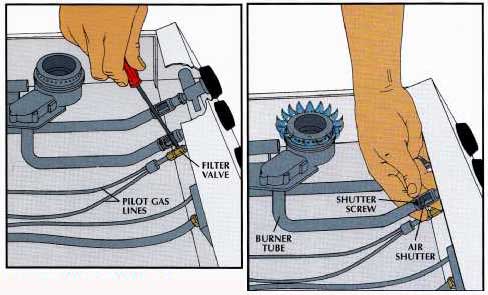 [PORTHOLES; FLASH TUBE; BURNER TUBE ] • To adjust the airflow to a burner, first turn off all the burner controls. Locate the air shutter on the burner tube near the front of the stove. • Loosen the shutter screw until the shutter either twists or slides freely, then turn the burner on high. • Adjust the shutter by hand until the burner has the correct airflow and retighten the shutter screw. Adjusting the pilot flame. • Follow the thin pilot gas lines to the filter valve at the front of the stove. • Find the screw on the side of the valve, and turn it with a screwdriver until the pilot flame is a compact blue cone with little or no yellow at the tip. COMMON PROBLEMS WITH A GAS OVEN Exposing the pilot and burner. 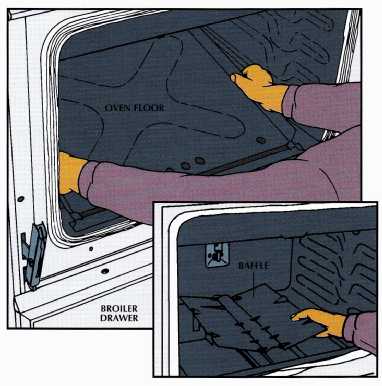
Loosen any tabs or screws holding the oven floor in place, and lift it from the oven. Below the floor is the burner baffle, often held in place by wing nuts. Remove them and the baffle, then pull the broiler drawer out of its opening and set it aside. Adjusting pilot and burner flames. 
• Relight the pilot if it has gone out. If not, in crease its height. Pull the oven thermostat knob from its shaft to reveal an adjustment screw labeled “constant pilot,” and turn it clockwise. • Replace the knob and turn on the oven. If the burner still does not light, the thermostat or safety valve must be replaced. Call a repair service. + To adjust the burner flame, turn off the oven and loosen the air-shutter screw. Change the shutter opening, then remove your hand from the oven and turn on the oven to observe the flame. • Make additional adjustments as needed, each time turning off the burner before reaching into the oven. • When the flame is satisfactory, turn off the oven, tighten the shutter screw, and replace the baffle and oven floor. Testing the oven flame switch. 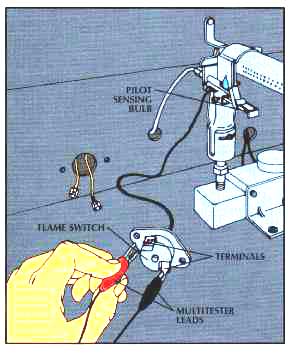
+ Turn off electrical power to the range, check that the pilot flame is burning, then unscrew the switch from the rear oven wall. • Detach the wires from the two terminals on the back of the flame switch. Check for resistance between the flame switch terminals with a multitester set at RX1. A reading of 0 ohms indicates a properly working switch; call a repair service, and expect to have the oven thermo stat replaced. • If the multitester shows high resistance, replace the flame switch. Remove it by gently working the pilot sensing bulb from its bracket. To install a new switch, attach the wires to its terminals, screw it to the oven wall, and slip the sensing bulb into the bracket. Prev: When an Electric Range Fails to Heat Next: Two kinds of Range Hood Ventilators Home Similar articles top of page |